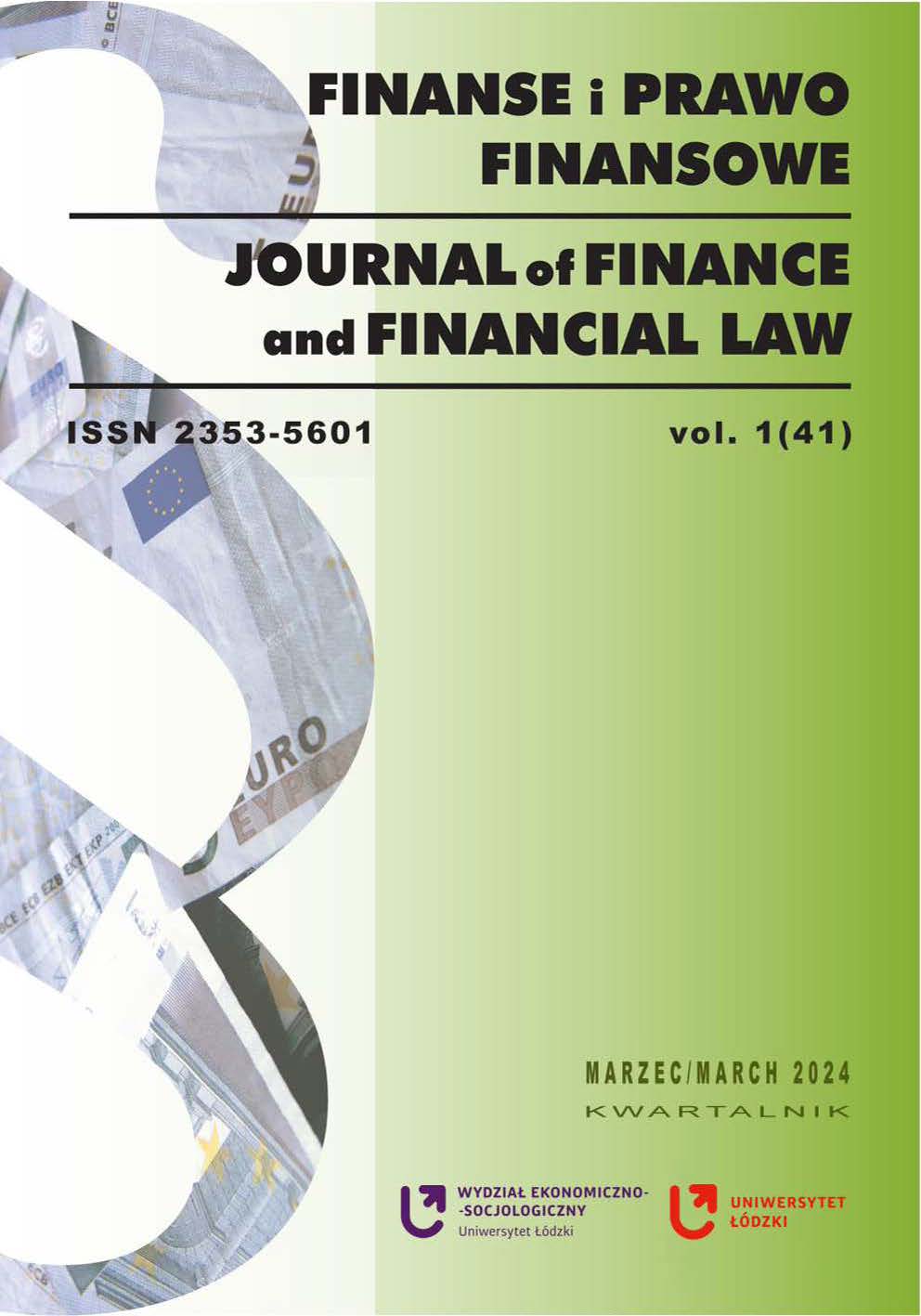Seasonal Fluctuations as a Result of Changes in the Investor Structure – A Case Study for the Warsaw Stock Exchange S.A.
DOI:
https://doi.org/10.18778/2391-6478.1.41.06Keywords:
seasonality, calendar anomaly, investments, rate of return, emotionsAbstract
The purpose of the article. Seasonality in capital markets is described in the financial literature as a type of calendar anomaly that indicates irrational investor behaviour. One might ask whether there are reasons other than irrational investor behaviour for changes in the occurrence and magnitude of calendar anomalies. The paper hypothesises that changes in the structure of investors are responsible for the occurrence of seasonal anomalies.
Methodology. The analysis of seasonal fluctuations in the WIG index quotations for the years 1997–2022 was carried out using the CENSUS X12 procedure, with tests for the stability of seasonal fluctuations and the presence of moving seasonality. The assessment of the relationship between the strength of seasonal fluctuations, measured by the difference between the monthly extreme seasonal deviations in a given year, and the share of individual investors in the total number of stock market transactions on the Warsaw Stock Exchange was carried out using the Pearson linear correlation coefficient and the Granger causality test.
Results of the research. Periods of appearance and disappearance of seasonal fluctuations on the Polish stock market have been observed. Changes in the structure of investors were proposed as an explanation for this phenomenon. The periods in which the seasonality phenomenon was more intense coincided with the increased activity of individual investors. Therefore, it was not the description of the anomaly that was the reason for its disappearance, but its appearance and disappearance was linked to the structure of investors who showed certain constant behaviours.
Downloads
References
Alexander, S.S. (1961). Price Movements In Speculative Markets; Trends Or Random Walks. Industrial Management Review, 2.
Google Scholar
Asteriou, D. i Kavetsos, G. (2006). Testing for the Existence of the January Effect in Transition Economies. Applied Financial Economics Letters, 2(6), ss. 375–381, https://doi.org/10.1080/17446540600706817
Google Scholar
DOI: https://doi.org/10.1080/17446540600706817
Białek, W. (grudzień 2015–styczeń 2016). Rajd św. Mikołaja i efekt stycznia, czyli o cudach na giełdzie. Pieniądze & Inwestycje, 86.
Google Scholar
Borkowski, K. (2019). Występowanie efektu stycznia i grudnia na przykładzie spółek notowanych na GPW w Warszawie. Studia i Prace Kolegium Zarządzania i Finansów, 172, ss. 23–29, https://doi.org/10.33119/sip.2019.172.2
Google Scholar
DOI: https://doi.org/10.33119/SIP.2019.172.2
Chong, R., Hudson, R., Keasey, K. i Littler, K. (2005). Pre-Holiday Effects: International Evidence on the Decline and Reversal of a Stock Market Anomaly. Journal of International Money and Finance, 24(8), ss. 12261236, https://doi.org/10.1016/j.jimonfin.2005.08.015
Google Scholar
DOI: https://doi.org/10.1016/j.jimonfin.2005.08.015
Cisowski, K. (2023). Window dressing czy podaż z funduszy emerytalnych?, https://www.stockwatch.pl/wiadomosci/window-dressing-czy-podaz-z-funduszy-emerytalnych,akcje,306557 [dostęp 28.08.2023].
Google Scholar
Cont, R. (2001). Empirical Properties of Asset Returns: Stylized Facts and Statistical Issues. Quantitative Finance, 1, ss. 223–236.
Google Scholar
DOI: https://doi.org/10.1088/1469-7688/1/2/304
Cootner, P.H. (1964). The Random Character of Stock Market Prices. Cambridge: Mass., The M.I.T. Press.
Google Scholar
Czekaj, J. (2008). Rynki, instrumenty i instytucje finansowe. Warszawa: Wydawnictwo Naukowe PWN.
Google Scholar
Czerwonka, M. i Gorlewski, B. (2008). Finanse behawioralne. Warszawa: Szkoła Główna Handlowa.
Google Scholar
Darrat, A., Li, B. i Chung, R. (2013). On seasonal anomalies: A Closer Look at Johannesburg Stock Exchange. Contemporary Management Research, 9(2), ss. 155–168, https://doi.org/10.7903/cmr.10629
Google Scholar
DOI: https://doi.org/10.7903/cmr.10629
Fama, E.F. (1965). The Behavior of Stock Market Prices. Journal of Business, 38(1), ss. 34–105, https://doi.org/10.1086/294743
Google Scholar
DOI: https://doi.org/10.1086/294743
Fama, E.F. (1970). Efficient Capital Markets: A Review of Theory and Empirical Work. The Journal of Finance, 25(2), ss. 383–417, https://doi.org/10.2307/2325486
Google Scholar
DOI: https://doi.org/10.1111/j.1540-6261.1970.tb00518.x
Fama, E.F. (1991). Efficient Capital Markets II. Journal of Finance, 46(5), ss. 1575–1617, https://doi.org/10.1111/j.1540-6261.1991.tb04636.x
Google Scholar
DOI: https://doi.org/10.1111/j.1540-6261.1991.tb04636.x
Eyuboglu, K. i Eyuboglu, S. (2016). Examining the January Effect in Borsa Istanbul Sector and Sub-Sector Indices. Pressacademia, 3(1), ss. 860–866, https://doi.org/10.17261/pressacademia.2017.666
Google Scholar
DOI: https://doi.org/10.17261/Pressacademia.2017.666
Gajdka, J. (2013). Behawioralne finanse przedsiębiorstw. Łódź: Wydawnictwo Uniwersytetu Łódzkiego.
Google Scholar
Granger, C.W.J. i Morgenstern, O. (1963). Spectral Analysis of New York Stock Market Prices. Kyklos, 16(1), ss. 1–27, https://doi.org/10.1111/j.1467-6435.1963.tb00270.x
Google Scholar
DOI: https://doi.org/10.1111/j.1467-6435.1963.tb00270.x
Gu, A.Y. (2004). The Reversing weekend Effect: Evidence from the U.S. Equity Markets. Review of Quantitative Finance and Accounting, 22(1), ss. 5–14, https://doi.org/10.1023/b:requ.0000006183.42549.50
Google Scholar
DOI: https://doi.org/10.1023/B:REQU.0000006183.42549.50
Gu, A. i Simon, J. (2003). Declining January Effect – Experience in the United Kingdom. American Business Review, 21(2), ss. 117–121.
Google Scholar
Haugen, R.A. i Jorion, P. (1996). The January Effect: Still there after all These Years. Financial Analyst Journal, 52(1), ss. 27–31, https://doi.org/10.2469/faj.v52.n1.1963
Google Scholar
DOI: https://doi.org/10.2469/faj.v52.n1.1963
Hirsch, J. i Hirsch, Y. (2001). Stock Market Almanac: Widely Yearly Updates. Hoboken: Wiley & Sons, ss. 56–93.
Google Scholar
Jacobsen, B i Zhang, C.Y. (2013). Are Monthly Seasonals Real? A Three Century Perspective. Review of Finance, 17(5), ss. 1743–1785, https://doi.org/10.1093/rof/rfs035
Google Scholar
DOI: https://doi.org/10.1093/rof/rfs035
Johnson, E. i Tversky, A. (1983). Affect, generalization, and the perception of risk. Journal of Personality and Social Psychology, 45(1), ss. 20–31, https://doi.org/10.1037/0022-3514.45.1.20
Google Scholar
DOI: https://doi.org/10.1037//0022-3514.45.1.20
Karaszkiewicz, B. i Staniec, I. (2017). Testowanie występowania „efektu stycznia” na podstawie indeksu sWiG80. Polityki Europejskie, Finanse i Marketing, 17(66), ss. 73–82, https://doi.org/10.22630/pefim.2017.17.66.6
Google Scholar
DOI: https://doi.org/10.22630/PEFIM.2017.17.66.6
Lakonishok, J. i Smidt, S. (1988). Are Seasonal Anomalies Real? A Ninety-Year Perspective. Review of Financial Studies, 1(4), ss. 403–425, https://doi.org/10.1093/rfs/1.4.403
Google Scholar
DOI: https://doi.org/10.1093/rfs/1.4.403
Lewandowska. M. (2017). Efekt stycznia i efekt grudnia na Giełdzie Papierów Wartościowych w Warszawie. Journal of Capital Market and Behavioral Finance, 1(5), ss. 17–28.
Google Scholar
Malkiel, B. (2003). The Efficient Market Hypothesis and Its Critics. The Journal of Economic Perspectives, 17(1), ss. 59–82.
Google Scholar
DOI: https://doi.org/10.1257/089533003321164958
Mandelbrot, B. (1963). The Variation of Certain Speculative Prices. Journal of Bussines, 36(4), ss. 394–419, https://doi.org/10.1086/294632
Google Scholar
DOI: https://doi.org/10.1086/294632
McGroarty, F. i Urquhart, A. (2014). Calendar Effects, Market Conditions and the Adaptive Market Hypothesis: Evidence from Long-Run U.S. Data. International Review of Financial Analysis, 35, ss. 154–166, https://doi.org/10.1016/j.irfa.2014.08.003
Google Scholar
DOI: https://doi.org/10.1016/j.irfa.2014.08.003
Milo, W. (2003). Wybór portfela inwestycyjnego. Łódź: Wydawnictwo Uniwersytetu Łódzkiego.
Google Scholar
Moore, A.B. (1964). Some Characteristics of Changes In Common Stock Prices. W: P.H. Cootner, red., The Random Character of Stock Market Prices. Cambridge: MIT Press.
Google Scholar
Mościbrodzka, M. (2020). Zachowania i anomalie na rynku NewConnect. Wrocław: Uniwersytet Wrocławski.
Google Scholar
Murgea, A. (2015). January Effect and Market Conditions: a Case of Romania. Ovidius University Annals. Economic Sciences, 2, ss. 488–493.
Google Scholar
Osborne, M.F.M. (1959). Brownian Motion In the Stock Market. Operations Research, 7(2), ss. 145–173, https://doi.org/10.1287/opre.7.2.145
Google Scholar
DOI: https://doi.org/10.1287/opre.7.2.145
Peters, E.E. (1997). Teoria chaosu a rynki kapitałowe. Warszawa: WIG Press.
Google Scholar
Raharjo, A., Mubaraq, F. i Mundir, F. (2013). December Effect of Stock Market Return in Indonesia Stock Exchange 1998–2012. International Journal of Science and Research, 2(1), ss. 708–711.
Google Scholar
Rak, A. (2019). Rajd św. Mikołaja widoczny na rynku od 100 lat. Donald Trump jako Grinch tegorocznego efektu?, https://comparic.pl/rajd-sw-mikolaja-widoczny-na-rynku-od-100-lat-donald-trump-jako-grinch-tegorocznego-efektu/ [dostęp 28.08.2023].
Google Scholar
Samuelson, P.A. (1965). Rational Theory of Warrant Princing. Industrial Management Review, 6.
Google Scholar
Schwert, G.W. (2003). Anomalies and Market Efficiency. W: G.M. Constantinides, M. Harris, R. Stultz, red., Handbook in the Economics of Finance. Amsterdam: Elsevier Science B.V., ss. 939–972.
Google Scholar
DOI: https://doi.org/10.1016/S1574-0102(03)01024-0
Sharpe, W.F. (1966). Mutual Fund Performance. Journal of Business, 39(1), Part 2 (Suppl), January, 119–138, https://doi.org/10.1086/294846
Google Scholar
DOI: https://doi.org/10.1086/294846
Shiu, Y.W., Lee, C.I. i Gleason, K.C. (2014). Institutional Shareholdings and the January Effects in Taiwan. Journal of Multinational Financial Management, 27, ss. 49–66, https://doi.org/10.1016/j.mulfin.2014.05.005
Google Scholar
DOI: https://doi.org/10.1016/j.mulfin.2014.05.005
Stiglitz, J. (2000). The Contributions of the Economics of Information to Twentieth Century Economics. Quarterly Journal of Economics, 115(4), November, ss. 1441–1478. https://doi.org/10.1162/003355300555015
Google Scholar
DOI: https://doi.org/10.1162/003355300555015
Świder, W. (2019). Anomalie kalendarzowe na rynku NewConnect – efekt przełomu miesiąca, efekt miesiąca oraz efekt miesięcy zimnych. Pieniądze i Więź, 22(82), ss. 72–79.
Google Scholar
Tarczyński, W. (1997a). Rynki kapitałowe, Metody ilościowe. Vol. II. Warszawa: Placet.
Google Scholar
Tarczyński, W. (1997b). Efektywność działania Giełdy Papierów Wartościowych w Warszawie. Ekonomista, 4, ss. 521–538.
Google Scholar
Tarczyński, W. (1999). Próba badania efektywności rynku kapitałowego. Zeszyty Naukowe Uniwersytetu Szczecińskiego, Folia Oeconomica Stetinensia, 5, ss. 119–143.
Google Scholar
Thaler, R. (1992). The Winner’s Curse. New York: The Free Press.
Google Scholar
Trader 21 (2020). Inteligentny Inwestor XXI wieku. Tom III. Independent Trader.
Google Scholar
Ullah, I., Ullah, S. i Ali, F. (2016). Market Efficiency Anomalies: A Study of January Effect in Karachi Stock Market. Journal of Managerial Sciences, 1, ss. 31–44.
Google Scholar
Washer, K.M., Nippani, S. i Johnson, R.R. (2016). Santa Claus Rally and Firm Size. Managerial Finance, 42(8), ss. 817–829, https://doi.org/10.1108/mf-10-2015-0280
Google Scholar
DOI: https://doi.org/10.1108/MF-10-2015-0280
Verheyden, T., De Moor i L., Bossche, F. (2013). A Tale of Market Efficiency. HUB Research Papers, Economics and Business Science, 5(2), ss. 45–46.
Google Scholar
Zielonka, P. (2015). Giełda i psychologia. Warszawa: Wydawnictwo CeDeWu.
Google Scholar
Zubairu. M. i Oyedeko, Y.O. (2017). Santa Claus Rally and Nigerian Stock Market Return: An Illusion or Reality? Net Journal of Business Management, 5(1), ss. 1–5.
Google Scholar
Downloads
Published
How to Cite
Issue
Section
License

This work is licensed under a Creative Commons Attribution-NonCommercial-NoDerivatives 4.0 International License.














